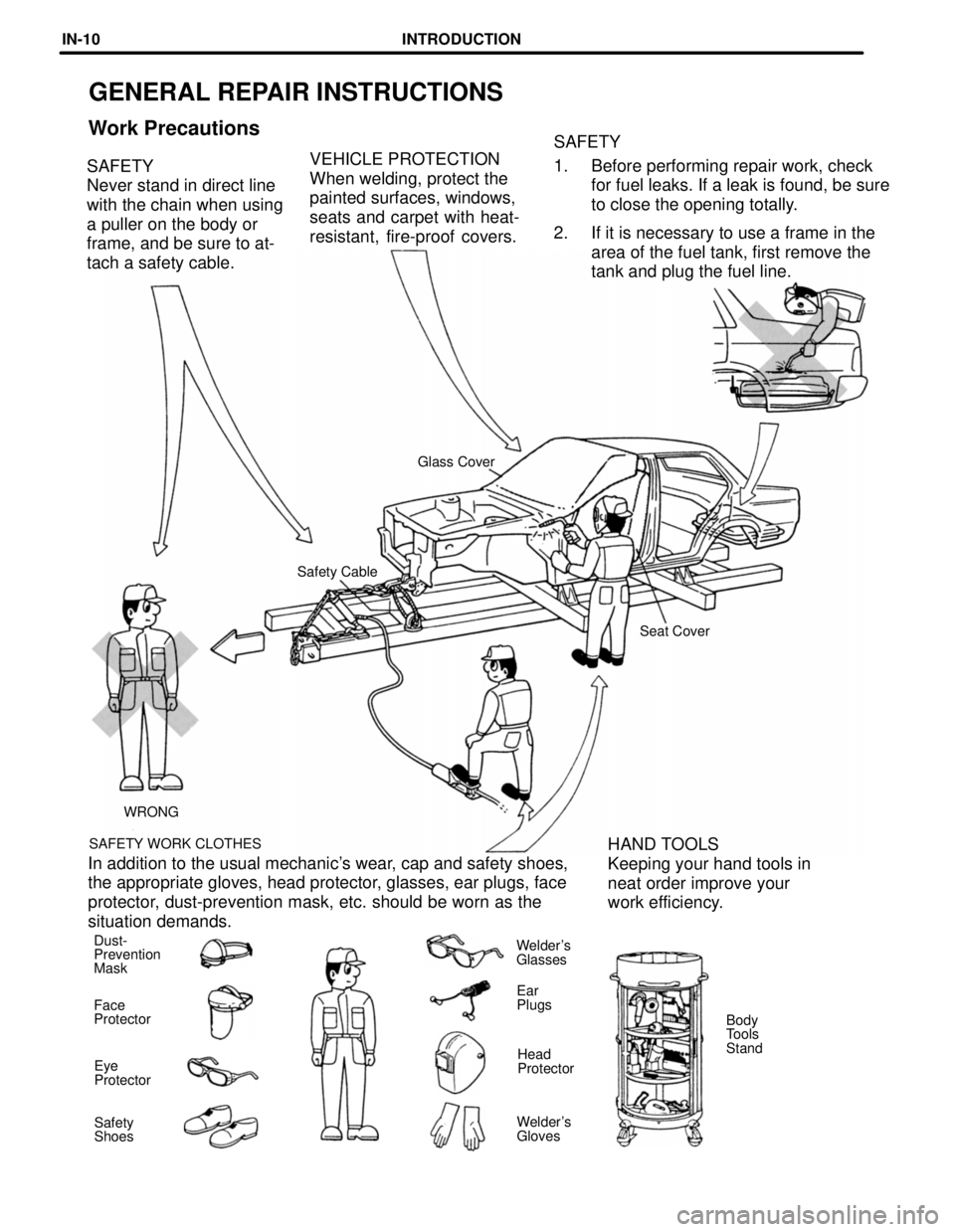Page 499 of 3115
BO1KI-01
- BODYSLIDING ROOF
BO-79
2653 Author�: Date�:
2004 LAND CRUISER (RM1071U)
REASSEMBLY
Reassembly is in the reverse order of disassembly (See page BO-76).
Page 500 of 3115
BO1KF-03
H05288
H05290
H05289
BO-74
- BODYSLIDING ROOF
2648 Author�: Date�:
2004 LAND CRUISER (RM1071U)
REMOVAL
1. REMOVE ROOF HEADLINING (See page BO-97)
2. REMOVE SIDE GARNISH
(a) Using a screwdriver, remove the garnish.
HINT:
Tape the screwdriver tip before use.
(b) Employ the same manner described above to the other
side.
3. REMOVE FRONT AND REAR GARNISHES
Using a screwdriver, remove the front and rear garnishes.
HINT:
Tape the screwdriver tip before use.
4. REMOVE SLIDING ROOF GLASS
(a) Remove the 4 nuts.
(b) Pull the glass upward to remove it.
5. REMOVE DRIVE GEAR
NOTICE:
Remove the drive gear with the sliding roof fully closed.
(a) Disconnect the connector.
(b) Remove the 2 bolts and drive gear.
(c) Using a screwdriver, remove the cam plate cover.
HINT:
Tape the screwdriver tip before use.
Page 501 of 3115
H05291Point Make
H05292
- BODYSLIDING ROOF
BO-75
2649 Author�: Date�:
2004 LAND CRUISER (RM1071U)
(d) Turn the drive gear to align the point marks as shown in
the illustration.
(e) Install the cam plate cover.
NOTICE:
At the time of installation, please refer to the following item.
If the sliding roof position and drive gear fully closed posi-
tion are not matched, the sliding roof does not operate nor-
mally.
6. REMOVE SLIDING ROOF HOUSING
(a) Remove the 4 drain hoses from the housing.
(b) Disengage the room light wire harness clamps.
(c) Remove the 8 bolts, 2 nuts and sliding roof housing.
Page 509 of 3115
BO1K7-04
H18903
Roof Headlining
Double Visor
Holder Inner Rear
View Mirror Double Visor
Sun Visor Sun Visor
Front Pillar Garnish
Outside No. 2 Moulding
Outside Upper Moulding
Front Assist Grip
Front Pillar Garnish Front Door
Opening Trim
Front Door
Opening Trim Windshield Glass
Dam Dam
Outside No. 2
Moulding Wiper Arm
Cowl Top Ventilator Louver LH
Hood to Cowl Top SealStopper
�
� �
: Specified torque
N´m (kgf´cm, ft´lbf)
� Non-reusable partOutside Moulding
Front Assist Grip
Overhead Console Box
Wiper Arm Head Cap
Wiper Arm
Cowl Top Ventilator
Louver RH
Outside MouldingCap
Cap
Holder
Assist Grip
Assist Grip
20 (204, 15)
20 (204, 15)
- BODYWINDSHIELD
BO-51
2625 Author�: Date�:
2004 LAND CRUISER (RM1071U)
WINDSHIELD
COMPONENTS
Page 514 of 3115

H02440
Riveter
Mandrel
H02441
Riveter
Riveter
H02442
Riveter
H04845
A
B
H21532
- BODYWINDSHIELD
BO-59
2633 Author�: Date�:
2004 LAND CRUISER (RM1071U)
NOTICE:
�Do not prize a riveter. It could damage the riveter and
cause loose fitting and mandrel bend.
�Do not tilt the riveter when fasten the rivet to the mate-
rial to avoid loose fitting.
�Do not allow gap spacing between the rivet head and
the material.
�Do not allow gap spacing between the materials.
(b) Use the same manner described above to the other side.
15. INSTALL COWL TOP VENTILATOR LOUVERS
(a) Install the cowl top ventilator louver LH.
(b) Install the cowl top ventilator louver RH.
16. INSTALL HOOD TO COWL TOP SEAL
17. INSTALL WIPER ARMS
(a) Operate the wiper motor once and turn the wiper switch
OFF.
(b) Install the wiper arms and tighten the nuts by hand.
(c) Adjust the installation positions of the wiper arms to the
positions as shown in the illustration.
A: Approx. 33 mm (1.30 in.)
B: Approx. 21 mm (0.83 in.)
(d) Torque the nuts.
Torque: 20 N´m (204 kgf´cm, 15 ft´lbf)
(e) Install the 2 wiper arm head caps.
18. INSTALL INNER REAR VIEW MIRROR
(a) Install the inner rear view mirror with the 2 screws.
(b) Connect the connector.
19. INSTALL FRONT SIDE OF ROOF HEADLINING
20. INSTALL ASSIST GRIPS
21. INSTALL OVERHEAD CONSOLE BOX
Connect the connector, then install the overhead console box
with the bolt.
22. INSTALL HOLDER
Install the holders with the screws.
Page 516 of 3115

BO4IU-01
H18904
H21423
4 Clips
H21532
BO-52
- BODYWINDSHIELD
2626 Author�: Date�:
2004 LAND CRUISER (RM1071U)
REMOVAL
1. REMOVE FRONT DOOR OPENING TRIMS
2. REMOVE FRONT ASSIST GRIP
(a) Using a screwdriver, remove the 2 assist grip plugs, then
remove the 2 screws and the front assist grip.
HINT:
Tape up the screwdriver tip before use.
(b) Use the same manner described above to the other side.
3. REMOVE FRONT PILLAR GARNISH
(a) Using a screwdriver, remove the front pillar garnish.
HINT:
Tape up the screwdriver tip before use.
(b) Use the same manner described above to the other side.
4. REMOVE SUN VISOR
(a) Using a screwdriver, remove the caps.
HINT:
Tape up the screwdriver tip before use.
(b) Remove the screws, then disconnect the connectors.
(c) Remove the sun visors.
5. REMOVE DOUBLE VISOR
Remove the screws and the double visors.
6. REMOVE HOLDER
Remove the screws and the holders.
7. REMOVE OVERHEAD CONSOLE BOX
(a) Remove the bolt.
(b) Using a screwdriver, remove the overhead console box,
then disconnect the connector.
HINT:
Tape up the screwdriver tip before use.
8. REMOVE ASSIST GRIPS
9. PULL DOWN FRONT SIDE OF ROOF HEADLINING
10. REMOVE INNER REAR VIEW MIRROR
(a) Disconnect the connector.
(b) Unfasten a screw, and remove the other screw and the in-
ner rear view mirror.
11. REMOVE WIPER ARMS
(a) Remove the 2 wiper arm head caps and the 2 nuts.
(b) Remove the 2 wiper arms.
12. REMOVE HOOD TO COWL TOP SEAL
13. REMOVE COWL TOP VENTILATOR LOUVERS
(a) Remove the cowl top ventilator louver RH.
Page 616 of 3115

GENERAL REPAIR INSTRUCTIONS
Work PrecautionsSAFETY
1. Before performing repair work, check
for fuel leaks. If a leak is found, be sure
to close the opening totally.
2. If it is necessary to use a frame in the
area of the fuel tank, first remove the
tank and plug the fuel line. SAFETY
Never stand in direct line
with the chain when using
a puller on the body or
frame, and be sure to at-
tach a safety cable.VEHICLE PROTECTION
When welding, protect the
painted surfaces, windows,
seats and carpet with heat-
resistant, fire-proof covers.
Glass Cover
Safety Cable
Seat Cover
WRONG
SAFETY WORK CLOTHES
HAND TOOLS
Keeping your hand tools in
neat order improve your
work efficiency. In addition to the usual mechanic's wear, cap and safety shoes,
the appropriate gloves, head protector, glasses, ear plugs, face
protector, dust-prevention mask, etc. should be worn as the
situation demands.
Dust-
Prevention
MaskWelder's
Glasses
Ear
Plugs
Face
Protector
Body
Tools
Stand
Head
Protector Eye
Protector
Welder's
Gloves Safety
Shoes
INTRODUCTIONIN-10
Page 623 of 3115

HANDLING PRECAUTIONS ON RELATED COMPONENTS
1. FOR VEHICLES EQUIPPED WITH SRS AIRBAG AND SEAT BELT PRETENSIONER
The TOYOTA LAND CRUISER is equipped with an SRS (Supplemental Restraint System), such as the driver
airbag and front passenger airbag and seat belt pretensioners. Failure to carry out service operations in the
correct sequence could cause the supplemental restraint system to unexpectedly deploy during servicing, pos-
sibly leading to a serious accident. Further, if a mistake is made in servicing the supplemental restraint system,
it is possible the SRS may fail to operate when required. Before servicing (including removal or installation of
parts, inspection or replacement), be sure to read the following items carefully, then follow the correct proce-
dure described in this manual.
�Malfunction symptoms of the supplemental restraint system are difficult to confirm, so the diagnostic
trouble codes become the most important source of information when troubleshooting.
When troubleshooting the supplemental restraint system, always inspect the diagnostic trouble codes
before disconnecting the battery.
�Work must be started after 90 seconds from the time the ignition switch is turned to the ºLOCKº position
and the negative (-) terminal cable is disconnected from the battery.
(The supplemental restraint system is equipped with a back-up power source so that if work is started
within 90 seconds of disconnecting the negative (-) terminal cable from the battery, the SRS may
deploy.)
When the negative (-) terminal cable is disconnected from the battery, memory of the clock and audio
systems will be cancelled. So before starting work, make a record of the contents memorized by the
audio memory system.
Then when work is finished, reset the clock and audio systems as before.
To avoid erasing the memory of each memory system, never use a back-up power supply from outside
the vehicle.
�Even in cases of a minor collision where the SRS does not deploy, the passenger's airbag assembly,
the steering wheel pad and seat belt pretensioners should be inspected.
Never use SRS parts from another vehicle. When replacing parts, replace them with new parts.
�Before repairs, remove the airbag sensor if shocks are likely to be applied to the sensor during repairs.
�Never disassemble and repair the airbag sensor assembly, steering wheel pad in order to reuse it.
�If the airbag sensor assembly, steering wheel pad have been dropped, or if there are cracks, dents or
other defects in the case, bracket or connector, replace them with new ones.
�Do not expose the airbag sensor assembly, steering wheel pad directly to hot air or flames.
�Use a volt/ohmmeter with high impedance (10 k�/V minimum) for troubleshooting of the electrical cir-
cuit.
�Information labels are attached to the periphery of the SRS components. Follow the instructions on the
notices.
�After work on the supplemental restraint system is completed, check the SRS warning light.
�Before repairing the body, remove the SRS parts if, during repair, shocks are likely to be applied to the
sensors due to vibrations of the body or direct tapping with tools or other parts.
�Do not expose the SRS parts directly to hot air or flames.
NOTICE:
1) The maximum ambient temperature tolerance is 120
°C (248°F) for the front airbag sensor, 105°C
(221
°F) for the center airbag sensor assembly and 93°C (200°F) for the steering wheel pad, and
front passenger airbag assembly. If it is possible that the ambient temperature may reach or ex-
ceed the temperature limit, remove the sensors and the steering wheel pad from the vehicle or
protect them with a hot insulation material before staring work.
2) Prior to welding, remove adjacent SRS parts form the vehicle or protect them with fire-proof cov-
ers.
�If the vehicle is damaged, visually inspect for damage to the steering wheel pad using the inspection
procedures described in section RS of the repair manual for the relevant model year.
INTRODUCTIONIN-6